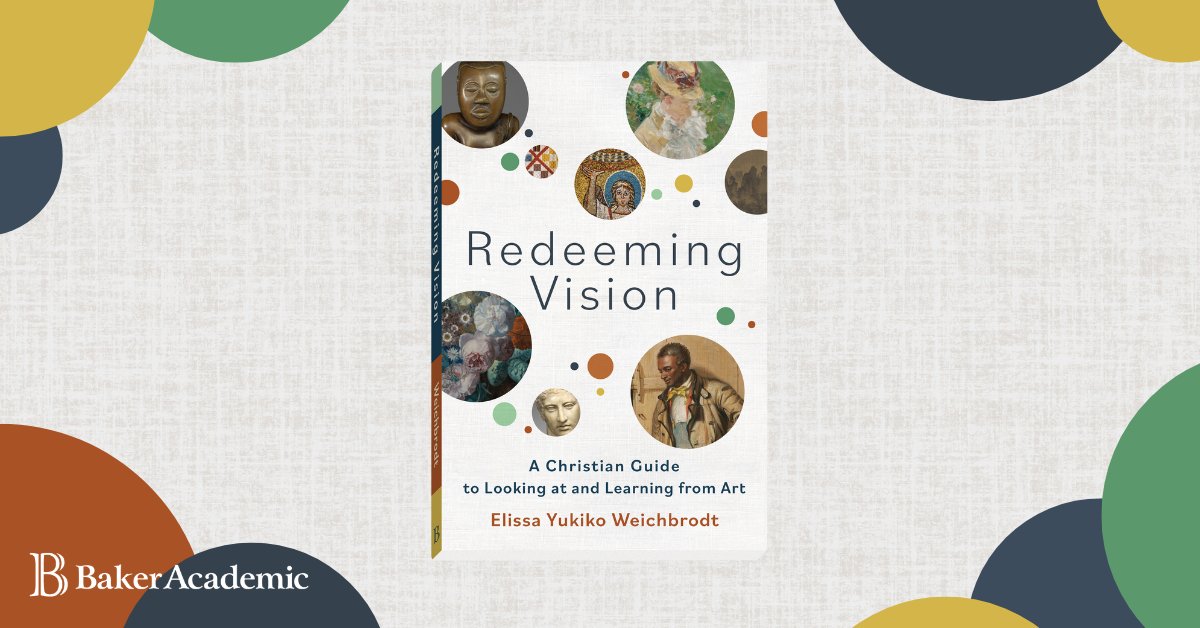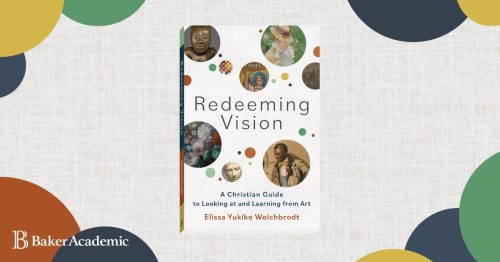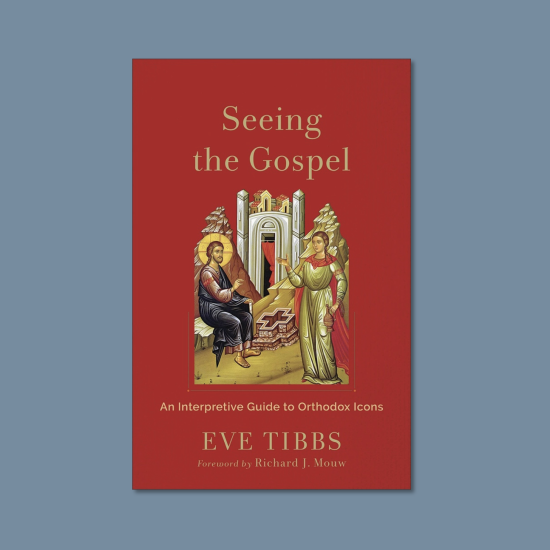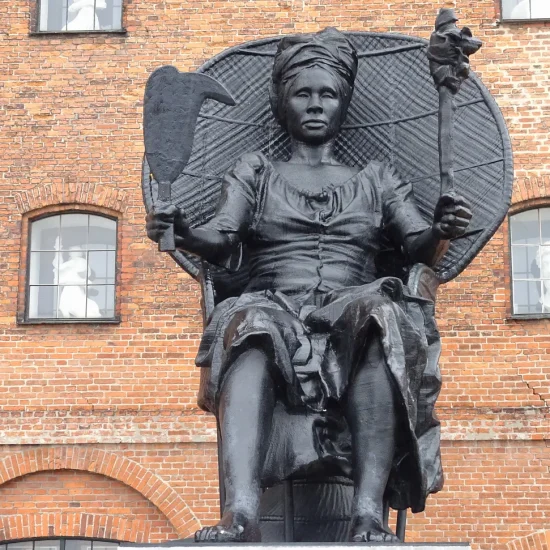

REDEEMING VISION: A Christian Guide to Looking at and Learning from Art. By Elissa Yukiko Weichbrodt. Grand Rapids, MI: Baker Academic, 2023. 266 pages.
They say that art is in the eye of the beholder. Some prefer more contemporary art, which might be quite abstract. Others prefer more realistic artwork. While photography might be considered realistic, it can be displayed in ways that are less straightforward than perhaps a painting. Understanding how to view or experience artwork, whatever its form, requires a degree of education or training or simply experience. I’ve been fortunate in recent years to live in a region that features a world-class art museum — the Detroit Institute of Art. When we travel to places like Chicago or Cleveland, we have the opportunity to spend time with great art. Great art can speak to us in many ways — spiritually, politically, etc. The Detroit Institute of Art features a mural by Diego Rivera (husband of Frida Kahlo) that describes in great detail the Detroit automotive industry. It has political implications, as Rivera was known to have Marxist leanings, something critics brought up. Of course, the DIA has many medieval paintings that are quite religious, but these murals when experienced in person are powerful witnesses to the relationship of humans and machines.

Robert D. Cornwall
When it comes to viewing art, I’ve never been specifically trained to view it. However, the more time spent in various spaces, including museums, I developed a certain level of appreciation. But more can be learned. That’s where Redeeming Vision by Elissa Yukiko Weichbrodt comes in. She writes from a Christian perspective, offering guidance to other Christians to view art in appreciative ways. In doing so she helps us view art through a theological lens, whether the artwork is religious in orientation or not. While she doesn’t speak to the Rivera mural, I will view it through a different lens the next time I visit the DIA (and I always spend time in the hall featuring the mural covering all four walls.
The author of Redeeming Vision, Elissa Yukiko Weichbrodt, is an associate professor of art and art history at Covenant College. She holds a Ph.D. from Washington University in St. Louis. She writes in the introduction to the book that this book is about more than speaking to those who go to art museums. While the book speaks to that part of our experience of art, she has more in mind than museumgoers. She writes for all of us who look at pictures. By this she means viewing Instagram photos, magazines, and graphic novels, to name a few forms. She asks us “What does your faith have to do with how you see?” (p. 9). That is, “How does being a Christian transform the ways you look at art … ?” When she asks these kinds of questions, she’s not speaking in terms of guardrails. That is, she’s not attempting here to tell us what not to see. Thus, she’s not interested in the question of whether depictions of violence or nudity should be avoided.
Instead of writing about fences, Weichbrodt speaks of ways in which our faith can serve as a lens through which we view pictures, including artwork. She writes with the assumption that we are more than viewers, but that are also makers. That is, she believes we should ourselves as culture makers. She writes that “when we look at art and images, we can do something with them. We are not simply consuming visual information or waiting for an artwork to stir our complacent souls.” Our viewing of pictures/artwork might lead us to a position of lament, or it could create curiosity or even delight. Central to her message is that “Our viewing becomes making when it grows our love for God and our neighbor” (p. 11).
Weichbrodt divides her book into three parts. Part 1 simply helps us learn “How to Look.” In this section of her book, the author provides us with a toolbox that we can use to engage in the visual analysis of pictures, art, and sculpture. She introduces us to such formal elements as line, shape, form, color, value, space, and texture (chapter 1). These tools will be utilized elsewhere in the book. Chapter 2 is titled “The Archive.” By that, she has in mind our past experiences in life and with art, which gives us a foundation for interpreting and experiencing what we see. That is, the archive is the lens through which we make meaning as we view pictures, whether a photo, sculpture, or painting. This is like a mental filing cabinet that we rifle through when we view something. Both the viewer and the artist have archives through which we view things, giving a context to understand and interpret what we see. In this chapter, the author uses a famous photo — “Migrant Mother” — as an example, helping us see things we might not otherwise see. The archive speaks to similar things we’ve seen and those that are different. Again, she’ll return to the concept of our archive throughout the book. Finally, in chapter 3, Weichbrodt speaks of the frame, or the physical context, in which the picture appears. Here she uses as a case study, Caravaggio’s “The Deposition.” She compares the original setting in a chapel over the altar, where a copy now appears, and the current location in the Vatican Museum. The question here concerns how context influences the way we view something, whether in a museum, online, or in its original location. She suggests that the frame shapes our experiences of the image.
Having set the foundations for viewing pictures/art, in Part 2 we move into more theological dimensions of this study. She titles this section “Love the Lord your God.” In these three middle chapters, she asks us to consider how the way we view art and images helps grow our love of God. She begins this section in chapter 4 with a discussion about “Confessing Our Idols.” This chapter includes a conversation about the iconoclastic debates of earlier centuries, but that’s not the primary point. More specifically she speaks of the idols of the perfect self and the ideal. She suggests, for example, that the “idealized form, built according to mathematical ratios, proposes a world where we become gods” (p. 101). Thus, idols need to be cast down. From there we move into chapter 5, where she offers us a conversation titled “Wondering at God’s Transcendence.” In this chapter, Weichbrodt speaks about transcendence in relation to abstract art, with a focus on Kandinsky’s “Painting with Green Center.” The conversation concerns how we might see something lying beyond the material, so that transcendence can be sensed in art. If Chapter 5 speaks of divine transcendence in connection with abstract art, chapter 6, which is titled “Delighting in God’s Presence,” focuses on representational art. In this chapter, which examines representational art, Weichbrodt speaks to divine immanence. Thus, we explore art that speaks to mundane things like a vase of flowers or an impressionist painting of a woman knitting, asking how these pieces reveal something about God.
Part 3 focuses on the call to “Love Your Neighbor as Yourself.” This section is composed of five chapters, beginning with chapter 7, is titled “Growing Curiosity” and focuses on portraiture. Regarding portraiture, the questions raised here have to do with the self, both public and private. So, how do portraits invite curiosity about those pictured? What do they generate within us? As we ponder these questions, we can better appreciate our neighbor. Chapter 8 is titled “Sharing Our Space” and explores landscape art. Landscapes speak of place and location. Our sense of identity is related to the spaces we inhabit. Thus, what do landscapes say to us? Then in chapter 9, titled “Allowing for Complexity” the author explores the “Art of the Everyday.” She points out that simplicity can conceal something important that requires some reflection. In this regard Weichbrodt points to William Sidney Mount’s “The Power of Music,” a painting that focuses on a barn. Inside are three white men, one of whom is playing a fiddle, while the other two listen. In the foreground, outside the door, hidden from the three white men, is a Black man, who is also listening. What does the artist want us to see in this picture? Is he speaking to the segregated nature of this scene, such that the Black man is not welcome to join the other listeners? It’s a very interesting conversation. The question here has to do with the complexity present in a scene, allowing us to explore what might be intended. The penultimate chapter (Chapter 10) is titled “Learning to Lament,” and is subtitled “The Art of History.” Here she explores how art is used to tell the story of history, using among others an ancient Assyrian scene that speaks of the Assyrian conquest of the Elamites along with an engraving made by Paul Revere of Henry Pelmham’s “The Boston Massacre.” Here she notes how Revere used this image in propagandist ways to support the cause of the revolutionaries, showing the British soldiers to be the bad guys.
The final chapter, titled “Redeeming Vision,” draws the preceding discussion to a close, helping us put together everything we’ve seen in the previous chapters. Weichbrodt asks us to consider this question “How do we look redemptively at a photograph that perpetuates a lie? Can a contemporary artwork that is a literal crack in the ground suggest a way forward?” (p. 236). Here she starts with a photo by John Choate titled “Tom Tolino—Navajo” It is a piece that features two pictures of Tom Tolino, one pictures the man as he entered the Carlisle School, looking very much like a Navajo. The second picture comes after Tom finishes school. In this picture, Tom is dressed in a suit with his hair cut short. These pictures were used to show the viewer how this man had been civilized by attending this school. But is this a true story? That is, does this picture tell the truth about a man or does it offer a Westernized vision of what a man living in the United States was supposed to look like? This raises the question of what happened at boarding schools like Carlisle that were designed to kill the Indian to save the man. The second piece is a photograph of the installation of Shibboleth, which is a crack created into a museum floor, which the author connected to the experiences of recent immigrants and the dangers of crossing borders (falling into the crack). In the end, there is a restoration, in which the rack is fixed, but not erased. Such is our reality. Things can heal but not be erased. The scars remain.
Elissa Yukiko Weichbrodt’s Redeeming Vision is a beautifully illustrated book (on glossy, high-grade paper we would expect from an art book) that should provide readers with important tools to explore images and see what is shared more deeply. She writes the book for Christians with the hope that it might help us look appreciatively at images, doing so through a theological lens that reveals our love of God and neighbor. Sometimes art is understood to be something to be enjoyed by the educated elite, but the reality is, we can all enjoy art, whatever our background. The Detroit Institute of Art is located in a predominantly Black city, with high poverty rates. While many who visit the museum come in from the suburbs much as I do, the DIA makes sure that the students in the Detroit School District have the opportunity to visit the museum and learn and experience what is found there, inspiring these students, many of whom come from poor families, to let loose their imaginations. The book is also a helpful contribution to the current political debates that are taking our schools hostage, seeking to limit exposure to the larger world. We only need to consider the decision to exclude from view a picture of Michelangelo’s David because the school leaders considered it controversial. Why was it deemed controversial? Well, David is nude, and we can see his penis. Perhaps some who read Redeeming Vision closely can get beyond such myopic views. For others of us, she gives lenses by which we can be inspired to love God and neighbor through our encounters with images and art, as we do we can become culture makers and not just enjoyers of culture!
This review originally appeared on BobCornwall.com.
Robert D. Cornwall is an ordained minister in the Christian Church (Disciples of Christ). Now retired from his ministry at Central Woodward Christian Church (Disciples of Christ) of Troy, Michigan, he serves as Minister-at-Large in Troy. He holds a Ph.D. in Historical Theology from Fuller Theological Seminary and is the author of numerous books including his latest “Second Thoughts about the Second Coming: Understanding the End Times, Our Future, and Christian Hope” coauthored with Ronald J. Allen. His blog Ponderings on a Faith Journey can be found at www.bobcornwall.com.






